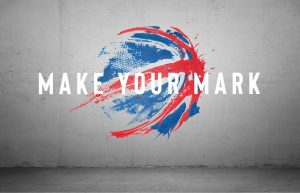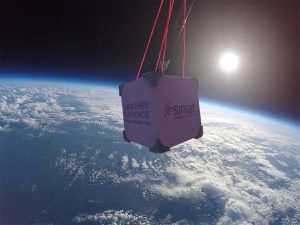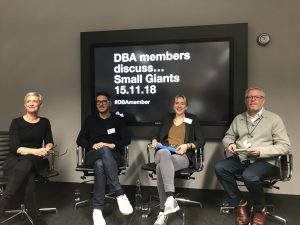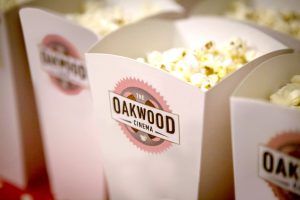Main Content

Sharing experiences to enrich your business
With the ‘DBA members discuss…’ event series really resonating with the membership, here’s a look back at a few snippets from the lively discussions around the country this year.
The greatest qualities of creative leaders
Held up and down the country this year, our ‘DBA members discuss…’ events have explored how design agencies tend to be different from many other owner-managed businesses.
The events have unpacked the attributes of design businesses, exploring the correlation between these and the characteristics outlined in Bo Burlingham’s Small Giants book and how, by understanding and nurturing these nuances within your own business, you can help to positively shape its future.
One key characteristic of Small Giant businesses is that their leaders see beyond the standard definitions of success (money and size) and look to explore bigger choices in the development of their business and the way they work.
At the Manchester ‘DBA members discuss…’ event, the BBC’s Ray Mosley and DBA Expert Ralph Ardill discussed the greatest qualities of creative leaders and what sets them apart from the rest.
Ray, who is the Executive Product Manager for Interactive TV at BBC Design & Engineering, spoke about how he believes a problem in leadership within the creative industries is the ownership of an idea. Ray believes great leaders let go of ‘things’ and concentrate on collective outcomes. To do this leaders are responsible for ensuring everyone understands the context of the situation. If everyone has an understanding of the constraints, the business goals, the KPIs, the context in which they are working, then the creative outcomes will be a better fit.
Ray highlighted two lessons he has learnt from being in a leadership position at the BBC:
- Knowing when to flex your leadership style. This is about being self-aware and conscious of how you are being received and thereby adapting how you behave depending on the situation and the people involved.
- Not acting quickly enough. When faced with difficult decisions, often involving personnel issues, it is easy to put off the decision. In hindsight it is almost always easy to see that the decision should have been made earlier. Leaders need to make the difficult decisions without shying away from them.
 Leadership is not purely facilitation. You can give your team autonomy and help them do their jobs to the best of their ability, but you also need to give guidance where it is needed. And as mentioned, make the difficult decisions.
Leadership is not purely facilitation. You can give your team autonomy and help them do their jobs to the best of their ability, but you also need to give guidance where it is needed. And as mentioned, make the difficult decisions.
Brand experience specialist and former Marketing and Strategic Planning Director at Imagination, Ralph Ardill drew on the wolf pack analogy –
When travelling over a long distance the leaders of the pack travel at the back. The leaders are able to make decisions with the perspective of everything they see in front of them. They are able to slow the pace to support an individual who is struggling, but they can also make the quick and ruthless decision to cut out a struggling individual once they think they are beyond salvaging and a detriment to the pack as a whole.
In response to the question “What are the greatest qualities of a leader?” Ralph Ardill replied “integrity” and “accountability”.
To have people buy into your vision, to follow your lead, you need integrity. They have to believe that you believe in what you say, that you will do what you say and live your ideals. If you say one thing, but do another you lose your integrity. Your team will not know where they stand with you and your business will flounder.
Accountability is the bond of trust between buyers and sellers. For an industry that sells ideas, accountability is key. Great leaders are able, not only of selling the idea, but also of managing the risk involved in implementing that idea. Our industry is all about transformational change, which is inherently risky. Leaders are accountable, not just for the great creative work their teams produce, but also identifying where the risk points are and addressing them head on.
Ray Mosely built on these two points, “Trust is an equation of consistency over time. When time is limited accountability builds trust.”
He gave the example of Swedish Spotify founder Daniel Ek who persuaded the Swedish music labels to give him the licenses to play their music. By pointing out the reduction in sales due to download piracy, he offered to pay the difference to stream their music. He mitigated their risk by making himself accountable for the shortfall. Spotify has not looked back since.
What size is a Small Giant business?

Five staff? Ten staff? Five hundred staff?
What is clear from the event discussions, is that the size of your team doesn’t matter. It’s the outlook of the business that counts: a drive to be the best they can be at what they do, to create a stimulating place for their staff to work, to provide great client servicing, to make a wider positive impact beyond simply their own financial gains.
It’s these characteristics that set many design businesses apart and align them with the Small Giants characteristics. Purposely small agencies like Supple Studios, agencies with a wide international reach like Elmwood and even companies like Arup (with 13,000 employees) have discussed at the events how they relate to the ethos of Small Giant businesses.
Simon Barbato, CEO of Mr B and Friends – a 40-person agency – spoke at the Bristol event, of a pod-system they were trialling throughout this year which would enable them to be a larger business, but maintain an entrepreneurial approach. They were only three months into the trial at the time, so we caught up with Simon again this month, to see how it was panning out.
You’ve been trialling a pod system at Mr B and Friends this year – why did you decide to introduce this?
Simply, as we had grown, we had introduced layers of process and agency management which was getting in the way of delivering what clients truly value from us: great work, responsive service, fair remuneration. We needed to return to the agility we had when we were a 10-12 person agency.
Who’s involved in the pods and how do they operate?
In each Pod we have around eight people: Pod is led by a senior client services, creative and planning person. Backed up with designer, art director, copywriter and account management. Pod resources are augmented by freelance and ‘floating’ talent: artworkers, senior management and junior creatives.

How has it impacted on your business?
Agility has returned. We no longer have gun fights between Account Directors at the scheduling meeting, meaning that each Pod acts like a micro business within the larger agency infrastructure.
It’s delivered closer working relationships with clients and greater exposure across the Pod to the client business – rather than just client service.
Responsibility and team work has increased as the smaller teams search for quality and competitive commercials across revenue and profitability.
It’s still a work in progress and we’re still ironing out issues, knowledge gaps etc, but it’s definitely a model that will help us to scale beyond the current number of 40 without losing quality, responsiveness etc.
And the reaction from clients?
Great! They really love the fact that they have more agility, better access to the team and arguably better value from us.
How integral is the pod-system now, to the future plans for your business?
Very. It will help us to scale in a structured way. It may be a good model for acquisitions to be on boarded into the agency and ensure business as usual without the usual mergers and acquisitions disruption, and of course if we have a big project, we could establish a pop-up Pod.
Defining and shaping growth

At the London event last week, industry expert Michael Thomson pointed out how many different definitions of ‘growth’ people have and that within a business you have to be honest with your partners on what your idea of growth is.
At the Midlands event, Paul Brammer, MD at Exesios explained why instead of replacing two members of staff who had left the business, they decided not to continue working with their largest client, which had turned out not to be a very profitable relationship. As a result, profitability at Exesios leapt from 17% to 34%.
Having a firm handle on how and why you grow is fundamental, and this excellent article by David C Baker offers some clear perspective and pointers on this.
When there's more to life than money
 Whilst being profitable is key to being a well run design business, other drivers are also paramount to how many members view their success and impact.
Whilst being profitable is key to being a well run design business, other drivers are also paramount to how many members view their success and impact.
We’ve been left especially inspired this year from hearing how DBA members are working with and for their local communities for far-reaching, meaningful effect. Thompson Brand Partners’ initiative, which their owner and CD Ian Thompson talked about at the Leeds event, is particularly heart warming.
Three years ago Thompson Brand Partners helped to found a community cinema with the express wish of getting elderly local residents, many of whom have lost their partners, out at least once a month. Sometimes some ideas can snowball and three years on and they sell out every month with 150 visitors.
 Thompson Brand Partners are based in a residential area in Leeds and have always felt a part of the community. For Owner and Creative Director Ian Thompson, this engagement is “simply good citizenship and it stops you feeling separated and in a different world to everyone else around you.”
Thompson Brand Partners are based in a residential area in Leeds and have always felt a part of the community. For Owner and Creative Director Ian Thompson, this engagement is “simply good citizenship and it stops you feeling separated and in a different world to everyone else around you.”
Ian explains of the cinema nights, “It’s strictly old school but with new technology. We deliver a proper big screen experience with good sound and a proper screen and projector. But we have an interval, so people can mingle and we’re happy for people to take their drinks into the auditorium. The fact people now expect it, is really the key to its sustainability and we really enjoy being involved.”
More to come...
“No man is an island, neither is our design agency! Joining the DBA has connected us with the invaluable experience of others, provided us with all-important benchmark data, and most of all, given us something vital: Community. ” Anton Van Shandwick, Director, Creative Coup
Keep an eye out for future ‘DBA members discuss…’ event dates around the UK and join us and your fellow members for insightful discussion, debate and networking, to enrich your business.
Image credits:
marcos luiz | Unsplash
Ray Hennessy on Unsplash
Mr B and Friends
Thompson Brand Partners